 Sometimes it is possible to diagnose hypospadias during pregnancy, but usually the diagnosis is only confirmed after birth.
Sometimes it is possible to diagnose hypospadias during pregnancy, but usually the diagnosis is only confirmed after birth.
There is definitely NO indication for abortion because of hypospadias.
Share
Questions and answers about Hypospadias.
 Sometimes it is possible to diagnose hypospadias during pregnancy, but usually the diagnosis is only confirmed after birth.
Sometimes it is possible to diagnose hypospadias during pregnancy, but usually the diagnosis is only confirmed after birth.
There is definitely NO indication for abortion because of hypospadias.
 The exact cause of hypospadias is not known, but certainly it is not the parents fault. Usually hypospadias is sporadic. When one child has a hypospadias does not increase the chances of hypospadias for other children in the family. However, some families have genetic predisposition i.e., the father, uncle or grandfather had hypospadias and in those families, more than one child can be affected.
The exact cause of hypospadias is not known, but certainly it is not the parents fault. Usually hypospadias is sporadic. When one child has a hypospadias does not increase the chances of hypospadias for other children in the family. However, some families have genetic predisposition i.e., the father, uncle or grandfather had hypospadias and in those families, more than one child can be affected.
 There are some geographical and racial variations. Several publications report the incidence of hypospadias to be one in every 125 newborn boys. In the United States a study reported that hypospadias was the most common congenital anomaly among whites. The incidence has been rising during the 1970s and 1980s.
There are some geographical and racial variations. Several publications report the incidence of hypospadias to be one in every 125 newborn boys. In the United States a study reported that hypospadias was the most common congenital anomaly among whites. The incidence has been rising during the 1970s and 1980s.
Usually, parents seek surgical advice and have the son hypospadias corrected and never talk about it again. That is why hypospadias is not a public topic that people talk about.
 During the first 3 month of life. This is because the optimal window for hypospadias-correction is between 3 and 18 month. It is ideal to seek the advice of an experienced specialist.
During the first 3 month of life. This is because the optimal window for hypospadias-correction is between 3 and 18 month. It is ideal to seek the advice of an experienced specialist.
 The specialty of the surgeon is not important. What is important is that the surgeon must have special interest in hypospadias and performs adequate number of hypospadias operation per year to develop experience and to have good results.
The specialty of the surgeon is not important. What is important is that the surgeon must have special interest in hypospadias and performs adequate number of hypospadias operation per year to develop experience and to have good results.
An appropriate question the parents may ask before they decide on a particular surgeon is to ask the surgeon how many hypospadias repair does he perform per year and what are his results and complication rate?
There is general agreement supported by several scientific studies, that hypospadias repair should be limited to centers performing 50 hypospadias repair or more per year. The complication rate following distal hypospadias should be less than 10% (ideally less than 5%). The complication rate following proximal hypospadias should be less than 25% (ideally less than 15%).
 There are several factors that determines the severity of hypospadias. However as a general rule: if the opening is in the glans this is glanular hypospadias or Grade I. If the opening is in the outer half of the penis this is considered a moderate degree or Grade II. If the opening is in the inner half of the penis, this is proximal hypospadias or Grade III. If the opening is in the scrotum and the scrotum is usually bifid, this is perineal hypospadias or Grade IV Please see examples below.
There are several factors that determines the severity of hypospadias. However as a general rule: if the opening is in the glans this is glanular hypospadias or Grade I. If the opening is in the outer half of the penis this is considered a moderate degree or Grade II. If the opening is in the inner half of the penis, this is proximal hypospadias or Grade III. If the opening is in the scrotum and the scrotum is usually bifid, this is perineal hypospadias or Grade IV Please see examples below.
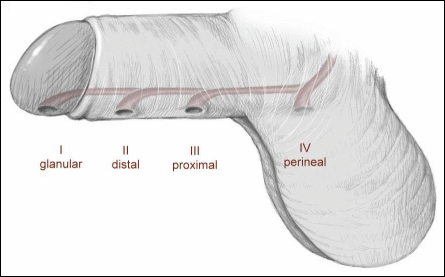
In reality the actual position of the meatus and the kind of the technique that is suitable for the child and the degree of curvature can only be accurately decided in the operating theatre when the child is asleep.
Mild or moderate degrees (grade I, II) of hypospadias constitute about 85 % of hypospadias. Proximal hypospadias constitute about 10%. Perineal hypospadias is about 5% of the total incidence of hypospadias.
Grade I: Glanular Hypospadias:
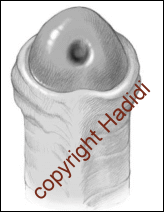
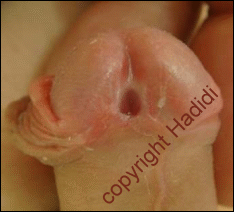
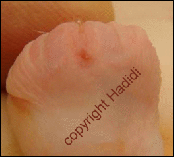
Glanular hypospadias is a mild form of hypospadias (10%). The urethral opening is in the glans. Usually, there is a bridge or skin fold just outer to the urethral opening which usually suggests that the urethra is long enough to reach the tip of the glans.
Mega- meatus Intact Prepuce (MIP) Hypospadias:
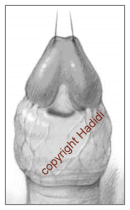

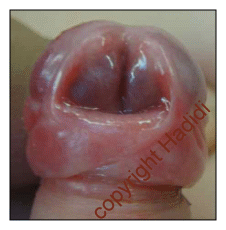
Megameatus Intact Prepuce hypospadias (MIP) is a rare form of hypospadias (2%) where the hypospadias is covered with a complete foreskin (unlike the majority of hypospadias where the foreskin is absent below) . This makes early diagnosis difficult and diagnosis can be only made when the parents or the surgeon retract the foreskin for cleaning or as a preparation for circumcision. A helpful sign is when the median raphe is rotated and not in the midline (see the photo above),
Grade II: Distal Hypospadias:
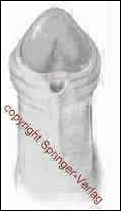
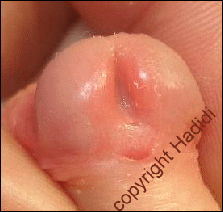
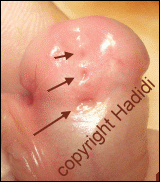
Distal hypospadias is the commonest form of hypospadias (75%) and the term is applied in all forms of hypospadias where the opening is within the outer half of the penis. Distal hypospadias may be associated with Chordee (penile curvature). However, the curvature is usually mild and is corrected by skin mobilization in most cases.
Grade III a: Proximal Hypospadias without deep chordee:
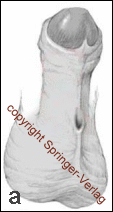
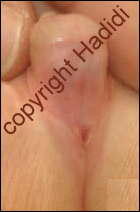
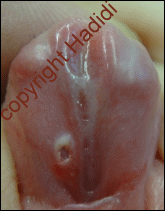
Proximal hypospadias is about 10% of the total hypospadias. About half of the proximal hypospadias (5% of the total hypospadias) has no chordee or superficial chordee only. The actual presence or absence of deep chordee can only be confirmed during surgery.
Grade III b: Proximal Hypospadias with deep chordee:
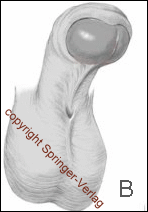
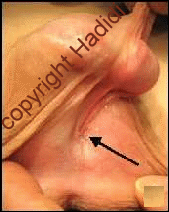
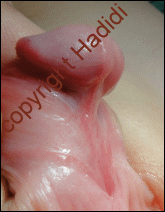
Proximal hypospadias with deep chordee represents about 5% of the total hypospadias. The first step in the operation is to correct the chordee before performing urethral reconstruction.
Grade IV: Perineal Hypospadias:
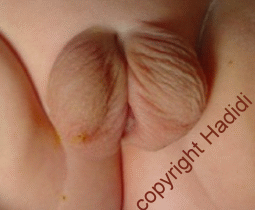

Perineal hypospadias is a severe form of hypospadias. It represents less than 5 % of hypospadias. Occasionally, it may be associated with undescended testis (in one or both sides) and it may be considered as a form of Disorders of Sexual Development (DSD). Pre-operative hormonal therapy may be helpful in a child with a small phallus.
 a) Glanular hypospadias (Grade I)
a) Glanular hypospadias (Grade I)
If the child has a glanular hypospadias (grade 1) the operation may not be necessary from the functional point of view. This means that he may not have problems with urination or with erections and sexual function later on in life. However, even this mild form of hypospadias may affect the child psychologically as the penis will not look normal and may result in wetting his cloths during urination or psychological problems. Many adults with uncorrected glanular hypospadias avoid having a partner as they do not wish that their partners realize that they have abnormally looking penis.
Professor Hadidi recommends to correct glanular hypospadias as the chances of having an almost normal looking penis after surgery is more than 99 % and the complication rate is 1 % only. Many adult patients with uncorrected glanular hypospadias attend the hypospadias clinic seeking surgical correction of the glanular hypospadias because of the psychological impact of the appearance.
b) Distal, proximal or perineal hypospadias (Grade II, III,IV):
If the child has distal (grade 2) , proximal (grade 3), or perineal hypospadias the operation is necessary to ensure adequate functions and appearance of the penis in the form of urination, erection and sexual function later on in life. Apart from the repair, children with hypospadias may have a very narrow opening that needs to be widened or dilated in order to avoid back pressure and infection of the bladder and kidneys.
 Yes, in children with glanular (Grade I), distal (Grade II) and the majority of proximal (Grade III) hypospadias, if the operation is done by an experienced surgeon. However in a small percentage of patients (especially in proximal or perineal forms) complications may occur that may impair the appearance or the function of the penis.
Yes, in children with glanular (Grade I), distal (Grade II) and the majority of proximal (Grade III) hypospadias, if the operation is done by an experienced surgeon. However in a small percentage of patients (especially in proximal or perineal forms) complications may occur that may impair the appearance or the function of the penis.
 Yes, in all children with glanular, distal and proximal hypospadias. Perineal hypospadias may have problems due to the size, curvature or surgical complications.
Yes, in all children with glanular, distal and proximal hypospadias. Perineal hypospadias may have problems due to the size, curvature or surgical complications.
 No. In principle, all the nerves responsible for erection and ejaculation run on the upper surface of the penis. All hypospadias operations for urethral reconstruction are performed on the ventral surface of the penis. So, there should be zero chance to damage those nerves. The only remote possibility is if the surgeon performs dorsal placation (Nesbit procedure or one of its modifications) to correct chordee or penile curvature, there may be a potential risk to damage these nerves.
No. In principle, all the nerves responsible for erection and ejaculation run on the upper surface of the penis. All hypospadias operations for urethral reconstruction are performed on the ventral surface of the penis. So, there should be zero chance to damage those nerves. The only remote possibility is if the surgeon performs dorsal placation (Nesbit procedure or one of its modifications) to correct chordee or penile curvature, there may be a potential risk to damage these nerves.
Information about the Hypospadias-surgery

Information, meeting, treatment

Blog and information about Prof. Dr. Ahmed Hadidi

General knowledge and information about hypospadias.

Publications by Prof. Dr. Hadidi

Do you have any further questions about our range of services?
